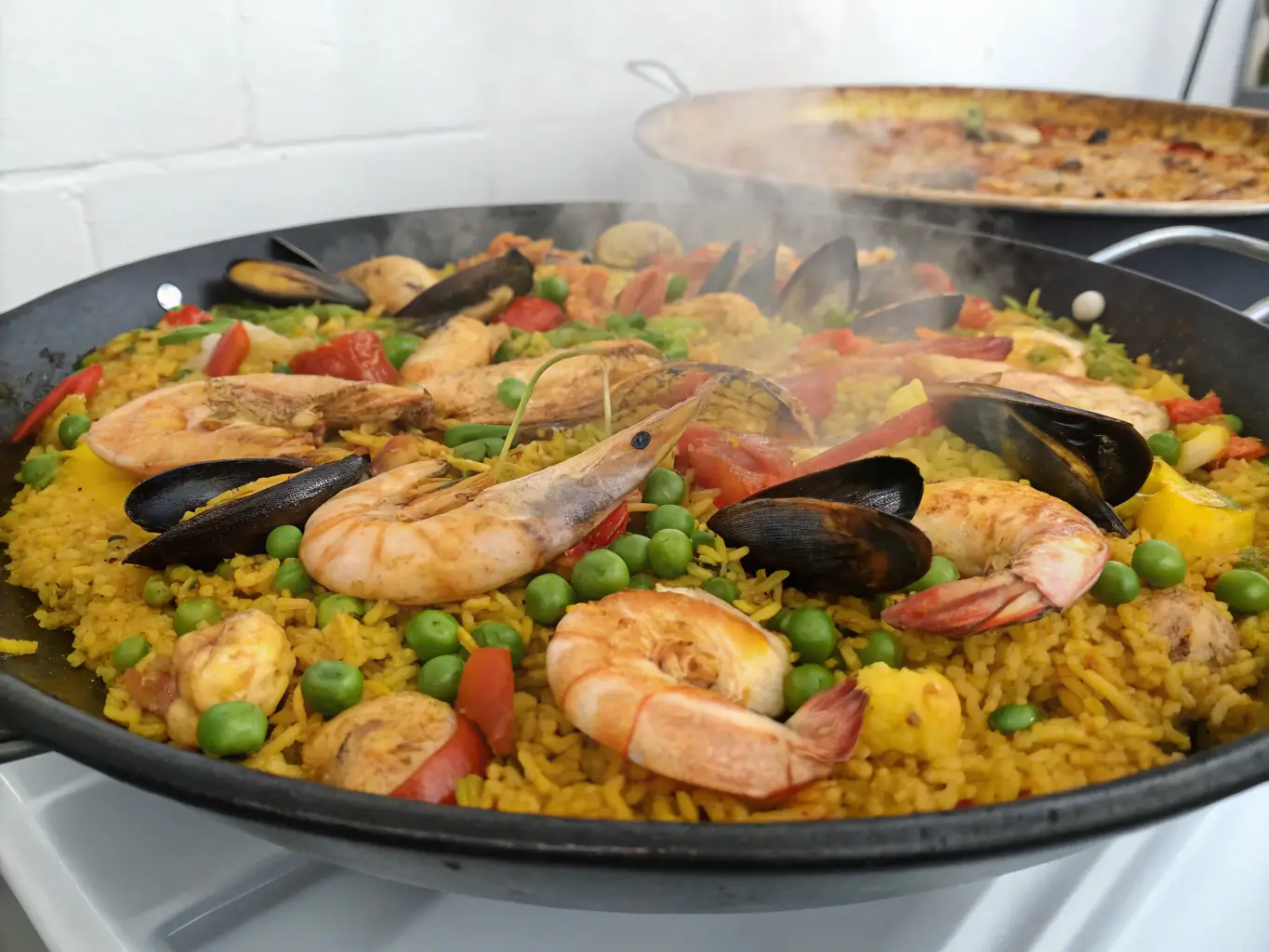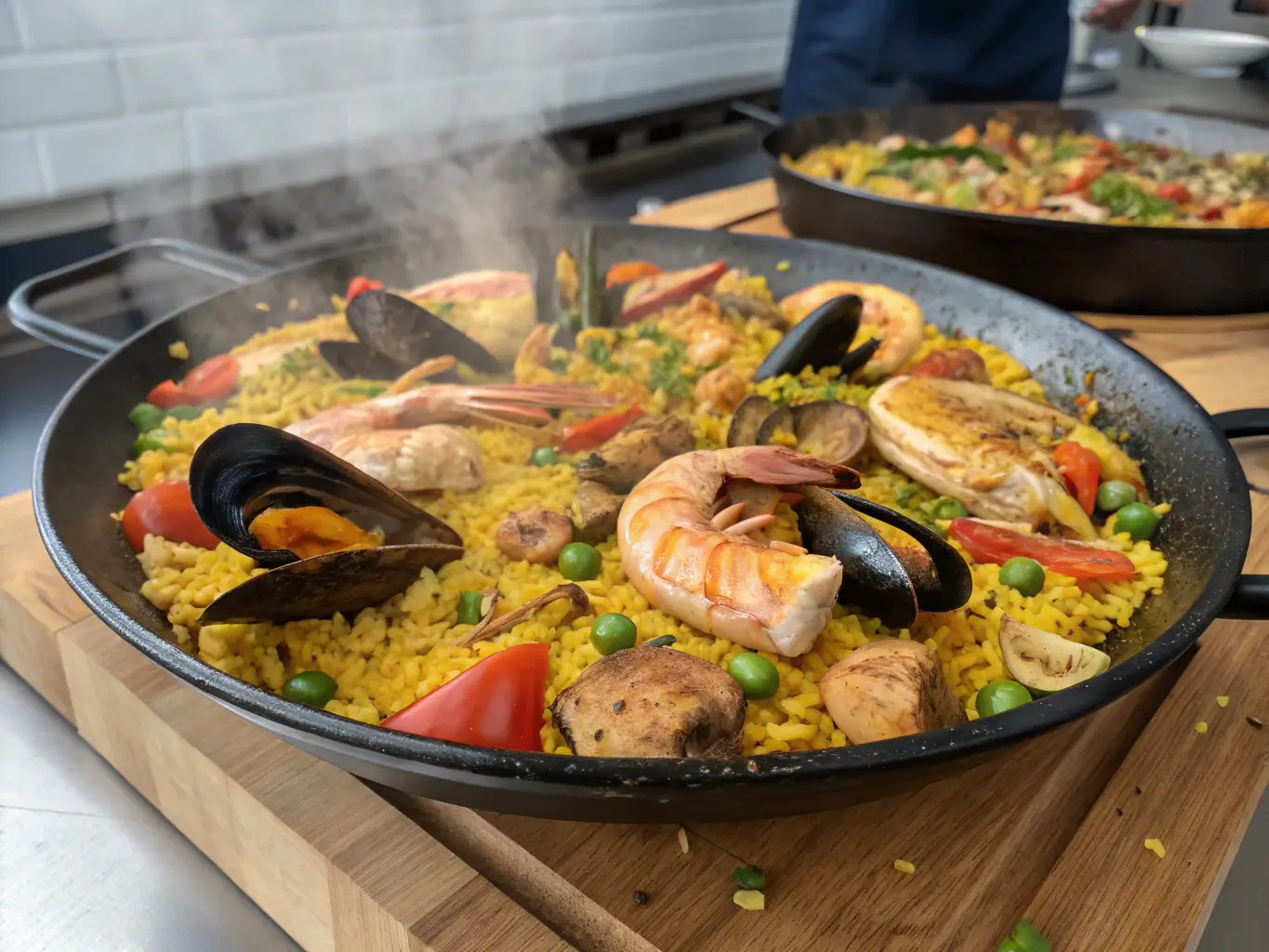Perfect Paella: A Step-by-Step Guide to the Ultimate Spanish Feast
Few dishes capture the vibrant spirit of Spain like paella—a saffron-infused, one-pan wonder bursting with flavors of the sea, land, or garden. Whether you’re hosting a festive gathering or craving a taste of Valencia, this authentic yet easy paella recipe delivers a restaurant-quality meal at home.
In this comprehensive guide, you’ll learn:
The secrets to the perfect socarrat (that crispy, caramelized bottom layer).
Flexible ingredient swaps for seafood, meat, or plant-based versions.
Pro tips to avoid common paella pitfalls and achieve flawless texture.
Essential tools and techniques for authentic flavor.
Let’s dive into this colorful, aromatic dish that’s as fun to make as it is to eat!

A Brief History of Paella
Paella originated in Valencia, Spain, in the 18th century, where farmers cooked rice with whatever ingredients were on hand—typically rabbit, snails, and seasonal vegetables like green beans and tomatoes. The dish evolved with Spain’s coastal trade, incorporating seafood such as mussels, shrimp, and squid.
The name comes from the wide, shallow “paellera” pan, designed to cook rice evenly over an open flame. Traditionally, paella was cooked outdoors over a wood fire, infusing the rice with a subtle smokiness.
Fun fact: Authentic Valencian paella never includes meat and seafood together—that’s a modern twist!
Why You’ll Love This Paella Recipe
One-pan wonder – Minimal cleanup, maximum flavor.
Endlessly customizable – Adapt with seafood, chicken, or plant-based proteins.
Aromatic and vibrant – Saffron and smoked paprika create an unforgettable scent and golden hue.
Perfect for gatherings – Cooks in under an hour, ideal for entertaining.
Crispy, caramelized socarrat – The hallmark of a well-made paella.
Essential Ingredients & Equipment
For the Paella Base
(Serves 6-8)
The Rice
- 2 cups (400g) Bomba or Calasparra rice – The best for paella, as it absorbs liquid without becoming mushy. (Substitute: Arborio rice if unavailable.)
- 4 cups (1L) chicken, seafood, or vegetable stock – Always use hot stock to maintain cooking temperature.
- 1 generous pinch of saffron threads – The soul of paella, providing color and aroma.
The Sofrito (Flavor Base)
- 1 large onion, finely diced
- 1 red bell pepper, thinly sliced
- 4 garlic cloves, minced
- 1 large tomato, grated (or 2 tbsp tomato paste) – Adds depth and sweetness.
- 1 tsp smoked paprika (pimentón) – Use sweet or bittersweet, not spicy.
- ½ cup (120ml) extra-virgin olive oil – Essential for flavor and preventing sticking.
Vegetables & Seasonings
- 1 cup (150g) green beans or broad beans – Classic in Valencian paella.
- 1 tsp sea salt – Adjust to taste.
- ½ tsp black pepper (optional)
Protein Options (Choose one or mix!)
- Seafood Paella: 12 mussels, 8 large shrimp (peeled & deveined), 1 cup squid rings.
- Chicken & Rabbit Paella: 2 bone-in chicken thighs, ½ lb (225g) rabbit (cut into pieces).
- Vegetarian Paella: 1 cup artichoke hearts, ½ cup chickpeas, 1 roasted red pepper.
Essential Equipment
- Paella pan (30-38 cm / 12-15 inches) – A wide, shallow pan ensures even cooking. (Substitute: Large stainless steel skillet.)
- Wooden spoon – For stirring the sofrito.
- Aluminum foil or clean kitchen towel – To rest the paella before serving.
Pro Tip: Never rinse Bomba rice—the starch helps create the perfect creamy-yet-firm texture!
Step-by-Step Cooking Instructions
1. Prepare the Stock & Saffron
- Heat the stock in a saucepan until hot (not boiling).
- Crush the saffron threads lightly and steep them in ¼ cup of hot stock for 10 minutes. This enhances color and flavor.
2. Make the Sofrito (Flavor Base)
- Heat olive oil in the paella pan over medium heat.
- Sauté onion and bell pepper until soft (5-6 minutes).
- Add garlic and cook for 30 seconds until fragrant.
- Stir in grated tomato (or tomato paste) and cook until thickened (3-4 minutes).
- Sprinkle in smoked paprika, stirring quickly to prevent burning.
3. Cook the Protein
- For meat: Brown chicken and/or rabbit pieces (5 mins per side), then set aside.
- Seafood: Quickly sear shrimp and squid (1-2 mins), then remove to avoid overcooking.
- Vegetarian: Lightly sauté artichokes and chickpeas (2-3 mins).
4. Toast the Rice
- Add rice to the pan, stirring to coat in oil (2 minutes).
- Pour in the saffron-infused stock and remaining hot stock.
- Arrange proteins and vegetables evenly—now, do not stir again (this is key for socarrat!).
5. Simmer to Perfection
- Cook uncovered on medium-low heat for 15-20 minutes.
- Listen for crackling sounds—this means the socarrat is forming!
- If rice is still undercooked but liquid is gone, add ¼ cup hot water.
- Remove from heat, cover with foil, and rest for 5 minutes.
Visual Cues for Doneness:
- Rice should be al dente (slightly firm).
- Liquid should be fully absorbed.
- The bottom should have a golden crust (not burnt).
Expert Tips & Troubleshooting
Rice too hard? Add a splash of hot stock and cook longer.
No socarrat? Increase heat for the last 2-3 minutes.
Mussels not opening? Discard them—they’re unsafe to eat.
Rice mushy? You may have stirred too much or used the wrong rice type.
For Perfect Paella Every Time:
- Use a wide pan to ensure even evaporation.
- Keep stock hot to maintain cooking temperature.
- Don’t cover while cooking—steam softens the rice too much.
Delicious Variations to Try
- Black Paella (Arroz Negro) – Made with squid ink for dramatic color and briny flavor.
- Vegetable Paella – Loaded with artichokes, roasted peppers, peas, and mushrooms.
- Mixed Paella – Combines chicken, shrimp, and seasonal vegetables.
- Lobster Paella – A luxurious twist for special occasions.
Serving & Presentation Tips
- Garnish with: Lemon wedges, fresh parsley, or a drizzle of garlic aioli.
- Pair with: A crisp green salad, grilled vegetables, or crusty bread.
- Serve in the pan for a rustic, family-style presentation.
Pro Tip: Let guests scrape the socarrat from the bottom—it’s the best part!
Storage & Reheating Instructions
- Fridge: Store leftovers in an airtight container for up to 2 days.
- Reheat: Sprinkle with water and warm in a skillet over low heat.
- Freezing: Not recommended—rice texture becomes grainy.

Frequently Asked Questions (FAQ)
Q: Can I use regular long-grain rice?
A: Bomba rice is best, but if using jasmine or basmati, reduce stock by ½ cup and monitor closely.
Q: Is saffron really necessary?
A: Yes! It’s irreplaceable for authentic flavor and color. Turmeric is not a good substitute.
Q: Can I make paella vegetarian?
A: Absolutely! Use vegetable stock and load up on seasonal veggies like artichokes, peas, and roasted peppers.
Final Thoughts
Now that you’ve mastered the art of authentic Spanish paella, it’s time to bring the flavors of Valencia to your kitchen. Whether you opt for seafood, meat, or a plant-based version, this dish is sure to impress.
Ready to cook? Gather your ingredients, fire up the stove, and let the aromas transport you to the Mediterranean coast.
Share your paella masterpiece with us! Tag your creations with #PerfectPaella—we’d love to see your culinary skills in action. 🥘
Happy cooking! 🇪🇸✨
